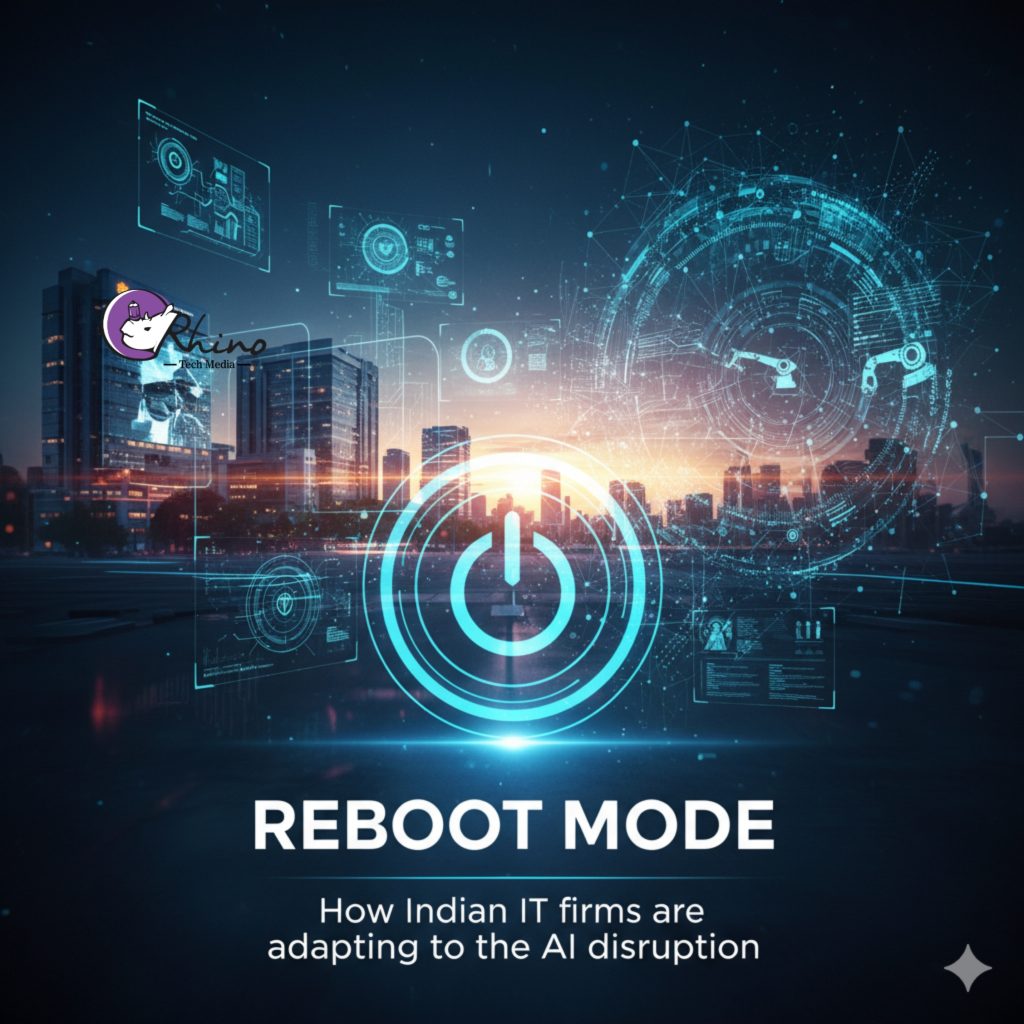Introduction
The Indian IT services industry, once built on the bedrock of labor-intensive outsourcing, is now undergoing a seismic transformation. The disruptive wave of artificial intelligence (AI), especially generative AI (GenAI), is compelling legacy IT giants such as TCS, Infosys, Wipro, HCLTech, and Tech Mahindra to fundamentally reassess their business models. This is not merely incremental change — it is, as many in the industry believe, a “civilisational shift” that demands reinvention.
This report explores how these companies are navigating the challenge of AI, the strategic moves they are making, the risks they face, and the opportunities that lie ahead.
The Drivers of Disruption
Several interlocking factors are driving this transformation in the Indian IT sector:
- Margin Pressure & Business Model Strain
Traditional IT services, especially those relying on labor arbitrage and outsourcing, are facing declining margins. As clients increasingly demand outcome-driven solutions rather than just bodies to deliver code, AI offers a way to deliver higher value with potentially lower cost. - Productivity Gains from GenAI
According to a survey by EY India, GenAI could boost the productivity of the Indian IT industry by 43–45% over the next five years. This enormous uplift comes from both internal efficiency (automation, AI-powered workflows) and client-facing projects moving from pilot to scale. - Client Demand Shift
Clients are no longer satisfied with simple digital transformation. They increasingly demand generative AI–powered solutions, intelligent automation, and AI-native applications. This forces IT vendors to evolve from a service provider to a co-innovation partner. - Technological Democratization
The falling cost of compute, more accessible AI models, and partnerships with cloud giants make it easier for Indian firms to embed AI into their offerings without having to build foundational models from scratch.
Strategic Responses: How Indian IT Firms Are Pivoting
Indian IT firms are adopting a multi-pronged strategy to adapt to this disruption. Here are some of the key themes:
- AI-Native Strategic Reorientation
Rather than trying to compete with model-creating giants like OpenAI or Google, Indian IT companies are positioning themselves as integrators of AI. They aim to embed AI into enterprise operations, rather than build core LLMs.- TCS has reorganized its business lines, merging AI and cloud into a unified “AI.Cloud” unit.
- Infosys calls its strategy “AI Your Enterprise,” focusing on AI agents and human-AI collaboration.
- Wipro realigned its global business lines to sharpen its focus on consulting-led, AI-powered client solutions.
- Tech Mahindra is using a tagline like “AI Delivered Right” to emphasize tailored enterprise-specific AI.
- Upskilling & Workforce Transformation
A central pillar of the reboot is reskilling large swathes of the workforce to be “AI-aware” or “AI-savvy.”- TCS claims that over 100,000 of its employees have acquired higher-order AI/ML and GenAI skills.
- Infosys reports 270,000+ employees are “AI-aware.”
- According to a Deloitte–Nasscom report, in 2023–24, TCS trained 350,000 employees and Wipro trained 220,000 on AI-related technologies.
- Internally, firms are organizing hackathons (e.g., TCS’s “Ideate and Build with AI”) and launch innovation programs to embed AI literacy deeply.
- Building Innovation Hubs & Co-Innovation Spaces
To accelerate AI deployment, major players are setting up dedicated labs, centers of excellence, and “AI foundries”:- TCS: AI Labs/expertise centers.
- Infosys: AI Foundry, where clients can experiment with agents and AI use-cases.
- Tech Mahindra: Its generative AI studio under the “amplify0→∞” suite.
- Partnership Model over Proprietary Model
Rather than developing LLMs on their own, Indian IT firms are leaning into partnerships with global hyperscalers and chip-makers:- Collaborations with Microsoft, Google, AWS to embed AI/GenAI into client solutions.
- Working with Nvidia and other hardware players to optimize deployment.
- Leveraging cloud platforms for scalable AI offerings rather than building costly infrastructure from scratch.
- Restructuring & Rebalancing Workforce
The AI disruption is also leading to workforce rationalization:- TCS announced a ~2% workforce reduction (over 12,000 jobs), especially in middle and senior management, as part of rebalancing with AI adoption.
- Rather than headcount growth, firms are focusing on reinventing roles, emphasizing quality over quantity.
- Business Model Innovation
- Indian IT firms are shifting from pure services to outcome-based, value-driven models.
- They are embedding AI agents in business operations – e.g., Infosys claims to have built 300 AI agents across IT, operations, and business functions.
- Some are also increasingly offering consulting, productization, and managed AI services rather than traditional staff-augmentation.
Risks, Challenges, and Constraints
Despite the robust strategies, Indian IT firms face several challenges in this AI reboot:
- Revenue Lag
While AI investments are heavy, translating them into consistent, high-margin revenue is not immediate. There is often a lag between experimentation (PoCs) and scaled deployment. - Legacy Systems
Many enterprises that Indian IT firms serve still run on legacy infrastructure. For AI to be effective, these systems need modernization, and data architecture must be made AI-consumable end-to-end. Infosys chairman Nandan Nilekani has emphasized this. - Talent vs. Headcount Trade-off
Upskilling and reskilling are expensive and time-consuming. Meanwhile, AI could reduce demand for certain roles, particularly repetitive or low-value tasks. Managing this shift without massive layoffs is a delicate balancing act. - Competition & Differentiation
Since many firms are pursuing similar partnerships and positioning (AI integrators), differentiation becomes harder. Moreover, they are not aiming to build foundational models, so their competitive moats may be narrower than pure AI-native companies. - Change Management
According to an AWS-led report, while 64% of Indian companies prioritize GenAI, 75% lack strong change-management plans to help employees transition to an AI-enabled work environment. - Economic Uncertainty
Macro risks (slowing demand, geopolitical issues, tariff uncertainty) compound the AI risk, forcing firms to make cautious bets.
Opportunities & Future Outlook
Despite the challenges, the AI disruption offers several promising opportunities for Indian IT firms — if they navigate well:
- Higher-Value Services
By embedding AI deeply within client operations (finance, customer engagement, product development), Indian firms can offer more strategic, high-margin services. - Agent-Based Automation
The development of AI agents (human-AI collaboration) could revolutionize not just internal workflows, but client solutions — giving Indian firms a differentiated edge. - Expanded Digital Consulting
As clients modernize, there’s huge scope in advisory, digital strategy, and managed services around AI, cloud, and data architecture. - Mid-sized Players’ Growth
Not just the big 4–5; mid-tier firms like LTIMindtree, Mphasis, Persistent, Hexaware are also leaning into AI, filing patents, building frameworks, and driving deals. - Societal Impact & Skilling
With large-scale reskilling, these firms can contribute to a broader national AI capability. The workforce transformation can also shape India’s long-term role in global AI. - Partnership Leverage
Deep alliances with hyperscalers and cloud players help firms scale quickly without bearing the full cost of infrastructure development.
Conclusion
Indian IT firms are not passively facing AI disruption — they are actively rebooting. The shift is not just technological but deeply strategic: from outsourcing-driven models to AI-native, outcome-based offerings; from headcount growth to skill reinvention; from labor arbitrage to high-value services.
However, the path ahead is fraught with risk. Success will depend on how effectively these firms convert their AI investments into revenue, manage workforce shifts without causing social dislocation, and differentiate themselves in a crowded competitive landscape.
If done right, this pivot could redefine India’s role in the global tech ecosystem — positioning its IT giants not just as service providers, but as indispensable partners in AI-powered transformation. The journey is risky, but the potential payoff is enormous: a stronger, smarter, and more strategic Indian IT industry, ready for the era of intelligent automation.

